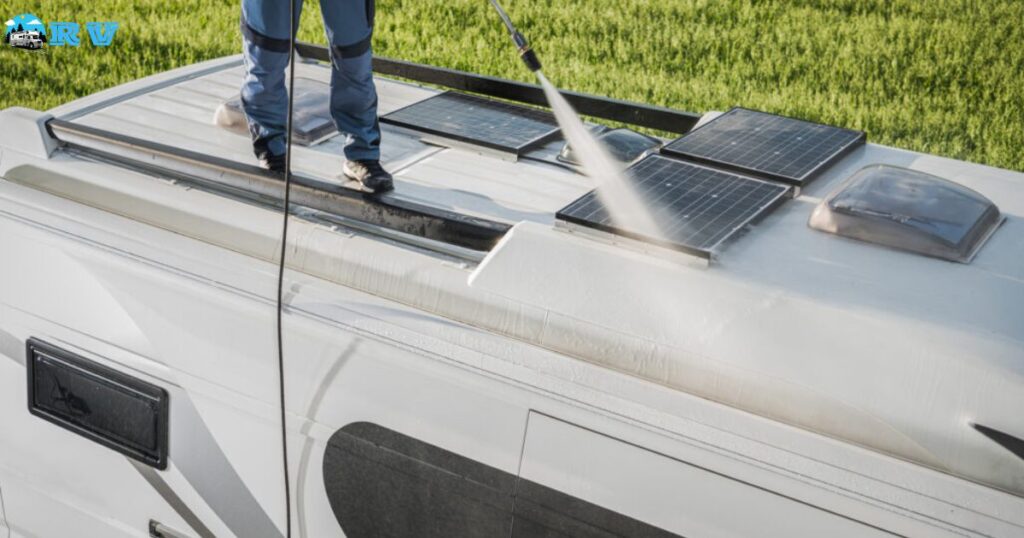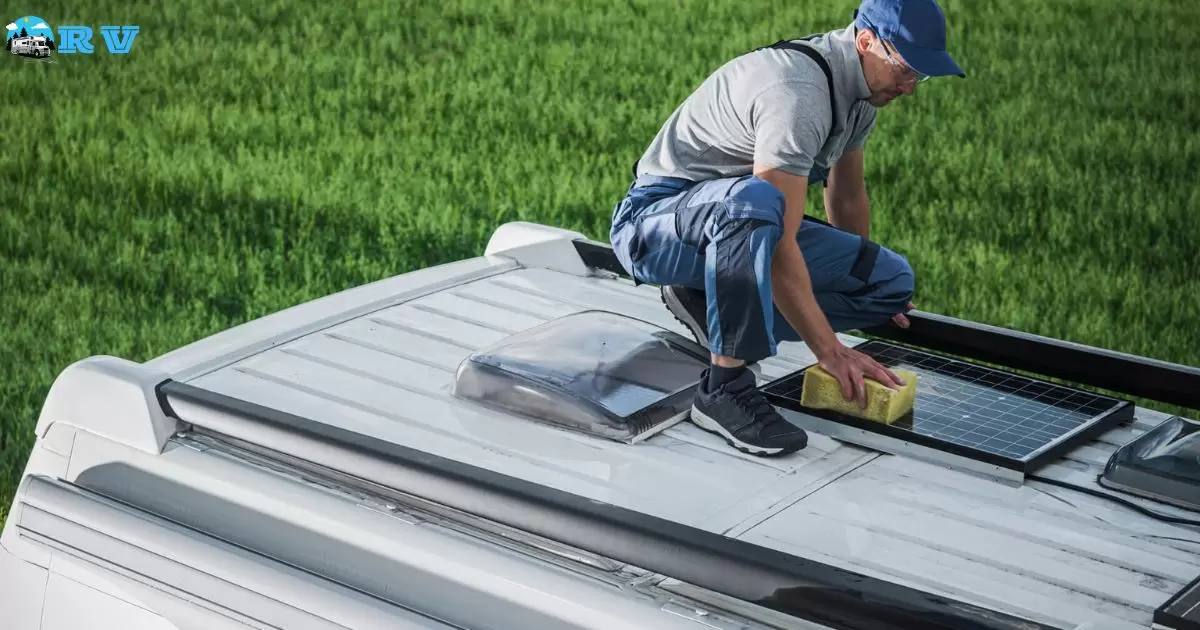Cleaning an RV roof before sealing refers to the essential process of preparing the roof surface of a recreational vehicle for the application of a protective sealant. This initial step involves the removal of dirt, grime, and contaminants that may have accumulated on the roof over time.
What to clean an RV roof with before sealing? This question is pivotal for RV owners seeking to maintain their vehicles’ structural integrity and appearance. Properly cleaning the roof sets the stage for successful sealing and, by extension, a longer lifespan for your cherished motorhome.
Cleaning the RV roof before sealing typically involves using specialised roof cleaners or mild, non-abrasive soaps, along with a soft bristle brush or sponge. These cleaning agents are gentle on the roof material, whether it’s rubber, fibreglass, or other types commonly found on RVs. Thoroughly cleaning and removing contaminants such as mold mildew.
Knowing What Material Your Roof Is
Before diving into the cleaning process, it’s essential to identify the type of roof material your RV has. RV roofs can be made of various materials, including rubber, fibreglass, aluminium, and more. The choice of cleaning products and methods may vary based on the roof material. Here’s a brief overview of common RV roof materials:
Rubber Roof
Rubber roofs, often made of EPDM (ethylene propylene diene monomer), are lightweight, flexible, and durable. They are known for their resistance to UV rays and weathering. To clean a rubber roof, you’ll need to use specific products designed for EPDM materials.
Fibreglass Roof
Fibreglass roofs are lightweight and offer excellent durability. They are often coated with a gel coat finish that adds an extra layer of protection. Cleaning a fibreglass roof requires gentle cleaning to preserve the gel coat. Avoid abrasive materials that could scratch the surface.
Aluminium Roof
Aluminium roofs are less common but still found on some older RVs. They are relatively easy to clean and maintain. Mild cleaners and non-abrasive tools can be used to clean aluminium roofs effectively.
Understanding your RV’s roof material is the first step in selecting the right cleaning products and methods for the job.
Choosing the Right Cleaner for Your Roof

Cleaning your RV’s roof is the first step in the maintenance process. You’ll want to remove dirt, grime, and any potential algae or mould growth to prepare the surface for coating. The choice of cleaner is crucial, as using the wrong product can damage the roof material.
For EPDM roofs, a mild dish soap and water solution is generally safe to use.
You can also find specialised EPDM roof cleaners designed to remove tough stains and algae growth without harming the material. Fibreglass roofs can be cleaned with a non-abrasive cleaner. Avoid using abrasive sponges or scrubbers, as they can scratch the surface. Mild detergents or specially formulated fibreglass roof cleaners work well.
How to Clean Your RV’s Roof
Cleaning your RV’s roof and ensuring it stays in top condition is not just about aesthetics; it’s essential for the longevity of your RV. Accumulated dirt and debris can lead to water damage, and algae growth can be particularly problematic. One crucial step in this maintenance process is to seal your RV roof. Here’s a more detailed guide on how to clean and seal your RV’s roof properly.
Gather Your Supplies: Before you start, make sure you have all the necessary supplies on hand. You’ll need a bucket, a soft brush or cloth, the appropriate cleaner for your roof material, and a hose for rinsing.
Safety First: Safety should always be a priority. Use a sturdy ladder to access the roof and wear appropriate footwear with good traction. If your roof is especially dirty or slippery, consider using a safety harness.
Remove Debris: Start by removing any loose debris, leaves, or branches from the roof. You can use a broom or a leaf blower for this.
Mix the Cleaner: Follow the manufacturer’s instructions for diluting the cleaner. In most cases, a mixture of cleaner and water will suffice.
Scrub Gently: Wet the roof with clean water, then use the soft brush or cloth to apply the cleaner. Scrub the surface gently, working in small sections. Avoid using abrasive tools that can damage the roof.
Rinse Thoroughly: Once you’ve cleaned the entire roof, thoroughly rinse it with clean water. Ensure that all traces of the cleaning solution are removed.
Can I Use a Pressure Washer on My RV Roof?
Pressure washers are powerful tools for cleaning a variety of surfaces, but they may not be suitable for all RV roofs. Whether you can use a pressure washer on your RV’s roof depends on the material and your experience using the equipment.
EPDM Roofs: While EPDM roofs can withstand gentle pressure washing, it’s essential to use low pressure (less than 1500 psi) and a wide fan nozzle to avoid damaging the material. Keep the nozzle at least a foot away from the roof’s surface and use a gentle, sweeping motion.
Fiberglass Roofs: Fibreglass roofs can generally handle pressure washing, but it’s crucial to use a low-pressure setting and be cautious not to get too close or use too narrow of a nozzle. High-pressure settings can cause damage to the fibreglass surface.
How Do I Prepare My RV Roof for Coating?
Preparing your RV roof for sealing is a crucial step to ensure the longevity and protection of your vehicle. Here are the essential tasks to complete when preparing your roof for coating:
Perform Repairs
Before applying a new coat or sealant to your RV roof, thoroughly inspect it for any damage or issues. Common problems may include:
- Leaks: Look for signs of water damage inside your RV, as this can indicate a leak on the roof.
- Sealant Damage: Check for cracks, gaps, or deteriorated sealant. If any areas require resealing, this is the time to address them.
- Lifting Material: If you have a rubber roof, check for any lifting or loose areas. These should be re-adhered before sealing.
Address any identified problems before moving forward with the sealing process. Repairing issues now can prevent more extensive damage in the future.
Roof Material Compatibility with Cleaners
| Roof Material | Recommended Cleaner |
| Rubber (EPDM) | pH-neutral rubber roof cleaner |
| Fiberglass | pH-neutral fiberglass cleaner |
| Aluminum | pH-neutral aluminum cleaner |
FAQs
Are pressure washers safe for cleaning my RV roof?
Pressure washers can be used with caution, using the lowest pressure setting to avoid damage.
How often should I clean my RV roof?
Cleaning your RV roof at least once a year is recommended to maintain its appearance and prevent damage.
Can I use regular household cleaners on my RV roof?
It’s best to use cleaners specifically designed for your RV’s roof material to avoid damage.
What should I do if I find damage on my RV roof during cleaning?
Address any damage, leaks, or sealant issues before proceeding with the sealing process.
Why is drying the roof important before sealing?
Ensuring the roof is completely dry is crucial to prevent moisture-related problems like delamination.
Conclusion
In the end, taking good care of your RV’s roof is key to keeping your home on wheels in great shape. By understanding your roof material and choosing the right cleaner, you set the stage for a successful cleaning process. Regular maintenance and attention to detail will help you enjoy countless more journeys with your RV.
So, as you prepare your RV roof for the next adventure, remember that a clean and well-maintained roof means a longer life for your beloved vehicle. Keep on exploring, knowing that you’ve done your part to ensure your RV stays in top condition for the road ahead.











